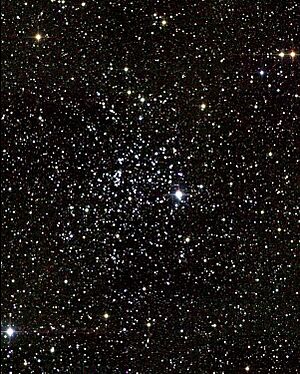Messier 52 facts for kids
Messier 52, also known as M52 or NGC 7654, is a group of stars that are close together in space. Astronomers call this kind of group an open cluster. It is found in the northern part of the sky, in a group of stars called a constellation. This constellation is named Cassiopeia, which looks like a "W" or "M" shape.
A famous French astronomer named Charles Messier first discovered M52 on September 7, 1774. You can actually see this star cluster from Earth using binoculars or a small telescope. It looks like a fuzzy patch of light in the night sky.
Contents
What is an Open Star Cluster?
An open star cluster is like a cosmic family of stars. These stars were all born at roughly the same time from the same giant cloud of gas and dust. They are held together by gravity, but not as strongly as other types of star clusters.
Because they are not tightly bound, open clusters tend to spread out over millions of years. They slowly drift apart as they orbit the center of their galaxy. M52 is a great example of this type of star group.
Where is Messier 52 Located?
Messier 52 is located in the Milky Way galaxy, our home galaxy. It is part of one of the Milky Way's spiral arms, called the Perseus Arm. This arm is one of the major spiral arms of our galaxy.
The constellation Cassiopeia is easy to find in the northern sky. It is visible for most of the year from the Northern Hemisphere. Finding Cassiopeia can help you locate M52.
How Many Stars are in M52?
Scientists estimate that Messier 52 contains hundreds of stars. These stars are mostly young and hot, shining with a bright blue-white light. Among them, there are also some older, cooler stars that appear more yellow or orange.
The brightest star in M52 is about 100,000 times brighter than our Sun. This star is a very hot and massive type of star. The cluster is quite far away from us, roughly 5,000 light-years from Earth. A light-year is the distance light travels in one year.
Discovering Messier Objects
Charles Messier was a comet hunter. He often saw fuzzy objects in the sky that looked like comets but were not. To help other astronomers, he made a list of these "non-comets." M52 is the 52nd object on his famous list.
Today, Messier's catalog is still very important. It helps astronomers find and study many interesting objects in space. These include star clusters, nebulae (clouds of gas and dust), and galaxies.
See also
 In Spanish: Cúmulo abierto M52 para niños
In Spanish: Cúmulo abierto M52 para niños


